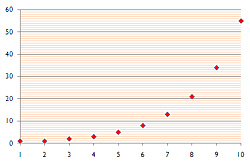Methods to Represent Sequences
A sequence can be represented in various ways, for instance:
- verbally,
- as a formula,
- as a table,
- as a (discrete) graph with individual points,
- as a graph, in which the points are connected.
Note: Not every sequence can be represented by a sequence 1 (see below).
Verbal representation
Verbal representation of a sequence means the description of the sequence with
words.
Representation as a formula
Some sequences can be represented by a formula, this means to give an algebraic relationship which describes the sequence. You distinguish between a explicit and a recursive definition (further details see next chapter).
However, representing a sequence as a formula is not always possible. For example, there is no formula for the sequence ( a n ) n = 2 , 3 , 5 , 7 , 11 , 13 ,... the prime numbers.
You obtain the Fibonacci sequence if you start with the numbers 1,1 and calculate every subsequent term as the sum of the two preceding terms
.
verbal representation of the Fibonacci- sequence
The Fibonacci sequence is fully described by a 0 = a 1 = 1 and

Representation as a table
In a table the mapping n ↦ a n can be given explicitly for some values of n.
 Start of the Fibonacci sequence given as a table
Start of the Fibonacci sequence given as a table
Representation as a graph
When we represent a sequence in the form of a graph we plot the index n ∈ ℕ of a term of the sequence on the x-axis against the value of that term on the y-axis. This gives a graph of discrete points. Sometimes, to emphasis the relationship of the change in value, the individual points are connected by a curve or line
 Start of the Fibonacci sequence as a graph.
Start of the Fibonacci sequence as a graph.
